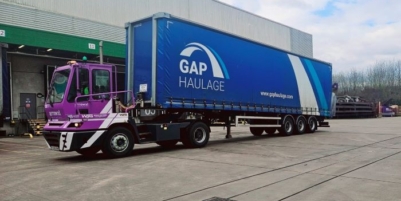-
Nutrivend selects Forterro’s Orderwise to support online expansion and streamline operations - April 11, 2025
-
ARROWXL LAUNCHES AMBITIOUS ZERO WASTE ROADMAP - April 8, 2025
-
THE BCMPA’S NEW CAMPAIGN DRIVES OUTSOURCING SUCCESS IN Q1 - April 7, 2025
-
BLACKOUT TECHNOLOGIES TARGETS TELEMATICS-INTEGRATED MOBILE DEVICE BLOCKING TO COMBAT SMARTPHONE DISTRACTION - April 1, 2025
-
Sparck Technologies awarded Royal designation - March 27, 2025
-
OpenADR Alliance announces first OpenADR 3.0 certified products with EVoke Systems, E.ON Energy and Universal Devices - March 25, 2025
-
Growing fulfilment and contract packer appoints new Managing Director - March 25, 2025
-
When is it time to invest in a WMS? Understanding the key trigger points - March 25, 2025
-
eCapital helps Vantage Recruitment on its journey to financial success - March 24, 2025
-
Hugo Beck Celebrates 70 Years of Packaging Innovation with Open House Events - March 20, 2025
On 1 April 2024, the UK government will introduce the largest ever increase to the minimum wage in cash terms. It will have significant implications for logistics operations, at a time when inflation continues to increase the overall cost of doing business. Eric Carter, an expert Solutions Architect at Indigo Software is advising warehouse managers to act quickly. He recommends adding a Warehouse Management System WMS solution to your logistics operations, to reduce the negative impact this rise will have on business profitability.
We all agree that no one should be forced to live in poverty and that employers should be paying a fair wage that allows all people to live a decent life. The government has recognised this and legislated that the National Living Wage should be increased and that the rises should apply to all workers aged 21 and over. The annual increases to the minimum wage and national living wage with effect from 1 April 2024 are as follows:
21 and over – £11.44 (increase of £1.02)
18-20 – £8.60 (increase of £1.11)
16-17 and apprentices – £6.40 (increase of £1.12)
These wage rises are very positive for millions of workers across the UK who have been struggling with the cost of living crisis. At the same time, many businesses are struggling for cash and finding it increasingly difficult to hire and retain good workers – especially in a fast moving environment like the warehouse. But what if you didn’t need so many people to run an efficient warehouse operation, because it was being supported by technology? Here are some of the ways a WMS will help you to rein in the rising costs of employing warehouse operatives.
Improved inventory visibility and accuracy
Real-time inventory tracking helps prevent problems associated with having too much or too little stock. By overseeing the inventory management function, a WMS will reduce the need for manual intervention and any reworking of tasks. Overall, by operating with improved accuracy levels as standard, your warehouse will be reporting fewer errors in order picking, packing, and shipping. This further improves efficiency by reducing the need to manually correct mistakes. Implementing automated cycle counting processes using a WMS reduces the need for extensive physical inventories, saving time and labour expenditure, while maintaining ultra accurate inventory levels.
Automates workflows to limit manual intervention
The need for manual intervention is minimised when using a WMS, because the software automates all routine tasks – everything from order processing and picking to packing and shipping orders. The WMS guides workers through every stage in a process and is set to automatically verify that each element was properly completed in a sequence. Over time you will notice you can run to maximum efficiency without needing to increase your head count, even during peak periods.
Optimised workforce management
If you are heading for a busy time, a WMS will ensure you don’t over staff the warehouse unnecessarily. It will optimise recruitment and workforce management by identifying priorities and workforce requirements in advance, with the required skill sets. This means warehouse managers can allocate human resources more effectively, avoiding overloading specific areas or unnecessarily hiring in expensive contract workers.
Streamlined order fulfilment
Picking and packing orders – especially for e-commerce sales – is time consuming and accounts for a large proportion of workforce costs in a warehouse. Using a WMS streamlines the entire order fulfilment process, reducing the time and labour required to pick and pack orders accurately. More advanced features like support for wave picking of multiple orders and pick route optimisation further enhance warehouse performance, ensuring efficiency levels are always maximised.
Reduced paperwork
A warehouse that is run with paper requires a high level of manual data inputting and administration – which is costly and time consuming. Added to this, the data being manually input is almost always out of date by the time it hits the back office database. By automating documentation and record-keeping with data captured at source and in real-time, a WMS saves on resource time and cuts the risk of errors.
Many companies that have introduced a WMS into their warehouse operations report significantly reduced labour costs as a result. Automating manual processes, optimising workflows, and achieving all round improvements to productivity and workforce efficiency can lead to significant cost savings in terms of reduced manual labour requirements and all the associated expenses of employing warehouse operatives. Even in a short to medium term timeframe, users will see a rapid payback on their investments.
To discuss how a WMS can help your company to mitigate the costs of increased wages contact Indigo Software.
About the author
Eric Carter is a Solutions Architect at Indigo Software
































